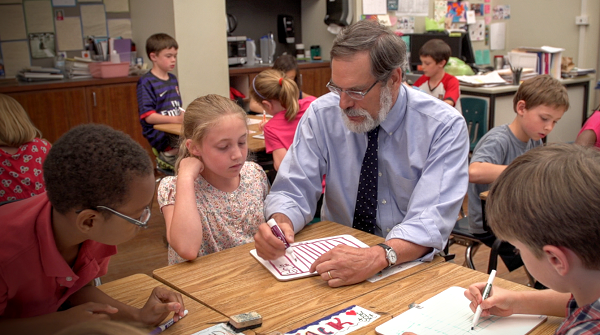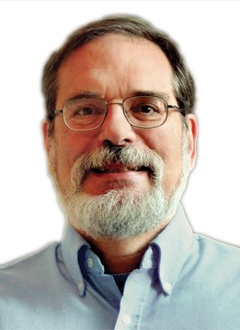
“I think the most serious missing piece in all the math I observe is that it stops at an answer.” —Steve Leinwand
If you’ve ever heard Steve Leinwand speak, you know he is energetic and opinionated. More importantly, he is fiercely devoted to the best possible mathematics instruction for all students. His two books, Accessible Mathematics and Sensible Mathematics, are bold and practical guides for shifting how we teach math in all grades. In the first of a two-part interview, we spoke with Steve about math education today, shifts he’d like to see more math teachers make, and the power of video for improving instruction.
If you could wave a wand and immediately shift one thing about how we teach mathematics today, what would you change and why would you change it?
Steve Leinwand: If I could make only one change, it would be quintupling the number of times the word why or its equivalent is uttered in a classroom by teachers and students. I think the most serious missing piece in all the math I observe is that it stops at an answer. If every answer was followed with, “Really? Why? How do you know? Where did that come from? Can you explain your thinking? Who did it differently? Who pictured differently?” I think we would significantly ratchet up the quality of thinking and reasoning in every class. I think why is really a Trojan horse into a classroom that focuses on thinking and reasoning and justifying—and that's what's needed in today's world.
You spend a lot of time in classrooms. What are some of the practices that you see really strong teachers use that make a difference in the effectiveness of their instruction?
SL: There is no doubt that what effective teachers do, teachers who maximize learning, is they differentiate on the basis of alternative approaches and multiple representations. Again, after this notion of, “Why? How do you know? How did you get that?” I think the most important piece for helping to make math work for far more kids is recognizing that there are 27 different brains and different styles in every classroom. Good instruction starts with an understanding that there is no one right way to get to one right answer; there are multiple solution paths and multiple ways of seeing and visualizing a problem. What I marvel at is when I sit in the back of a classroom and I see a teacher just naturally and seamlessly say, “Who did it differently? Who can show me a different approach?” or who goes, “How did you see it? How did you visualize it? What picture did you use? Who had a different picture?” Sharing that information is what builds a community of learners.
You talk often about the power of using video to watch and learn from other teachers but that it's something schools and districts often struggle with. Why is video such a powerful tool and why do so many schools struggle to use it?
SL: The real value of video is that it captures our practice and gives us something tangible to review, to study, to improve. That's why I think it’s just so important. When we look at curriculum and assessment, other people can see your work, other people can review your work, and other people can improve your work. You can touch and feel the curriculum; you can touch and feel the assessment. But if we don't videotape our instruction, it's ephemeral. Even if a few lucky people are in the classroom at the time you’re teaching, there's no record that allows us to go back to it if we don’t videotape it.
And I'm perfectly happy to just start with people watching themselves. I love it when teachers just put an iPad in the back of the room, press record, and then ignore it. Later on they watch it quietly by themselves through a very simple lens that says, “What really worked? What am I proud of in this lesson? What clearly didn't work? What is it that I have to improve?”
This idea of sticking an iPad in the back of the room and recording yourself just for yourself seems like it could combat the idea of videotaping as embarrassing or potentially punitive. Are there other things administrators can do to demystify using video so that it’s both seen and used in a wholly positive way?
SL: Administrators can first and foremost build trust and have transparency without the video, just by having collegial visits. I've been working in schools where the math coach and the principal have systematically designed a structure for professional collaborative visits. Teachers are identifying low-impact times when they can leave the classroom—when they are giving tests or when there's not a key lesson—when the math coach, or the principal, or a substitute can take over the class and that teacher can visit another classroom for an entire period. Then the visits are switched and there's an opportunity for reflection at the end of the day. When this happens, people go, “Whoa, this was really helpful! I wish other people could have seen it.” And then people say, “Well, you know, if we had videotaped this...” You can always edit it if necessary to leave out parts someone might be embarrassed by, but principals orchestrate these kinds of things. That's what leadership is about.
Even more importantly, I think the notion of transparency is still a dream in most schools. We don't always have a clear sense of what we're doing, we don't have a clear sense of why there are teachers who are so much more successful than others, and we need to capture that. It seems to me that faculty meetings ought to be primarily chances to look at instruction, to laugh together about how hard teaching is, about the mistakes that get made, about the missed opportunities and all of the opportunities that are taken. We need to be able to sit together as professionals and go, “Wow, I didn't think of that,” or, “Wow, I could do that.” I think that’s how we enhance the community of learners on the faculty. That's what transparency is about and that's how we have fodder for far more effective grade level teams and professional learning communities.
Click here to read part 2 of our interview with Steve.
♦ ♦ ♦ ♦
 Steve Leinwand is the author of the bestselling Heinemann titles Accessible Mathematics: Ten Instructional Shifts That Raise Student Achievement and Sensible Mathematics: A Guide for School Leaders in the Era of Common Core State Standards. He is Principal Research Analyst at American Institutes for Research in Washington, D.C., where he supports a range of mathematics education initiatives and research. Steve served as Mathematics Supervisor in the Connecticut Department of Education for twenty-two years and is a former president of the National Council of Supervisors of Mathematics. Follow him on Twitter @steve_leinwand.
Steve Leinwand is the author of the bestselling Heinemann titles Accessible Mathematics: Ten Instructional Shifts That Raise Student Achievement and Sensible Mathematics: A Guide for School Leaders in the Era of Common Core State Standards. He is Principal Research Analyst at American Institutes for Research in Washington, D.C., where he supports a range of mathematics education initiatives and research. Steve served as Mathematics Supervisor in the Connecticut Department of Education for twenty-two years and is a former president of the National Council of Supervisors of Mathematics. Follow him on Twitter @steve_leinwand.


